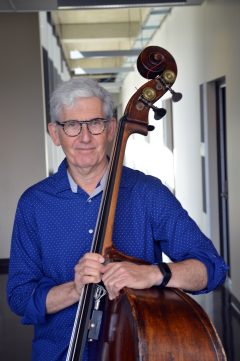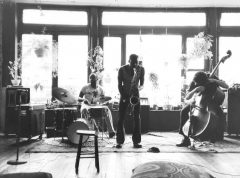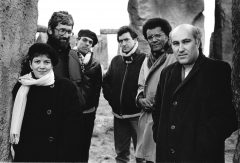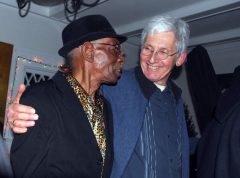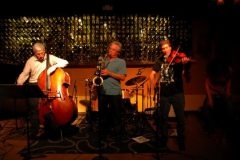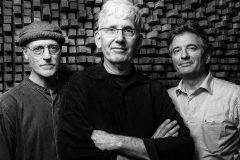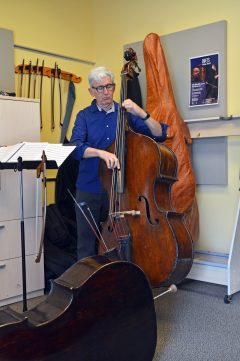Cover Story
The (R)evolution of Mark Dresser
I first encountered the force that is Mark Dresser at the tender age of 19, right about the time my adventure in jazz began. He was playing in a small art gallery downtown, with a group that featured vocalist Diamanda Galas, cellist Dave Millard, and multi-instrumentalist Jim French. This would have been in 1978. The music was very foreign to me, but Dresser cut an indelible impression–tall, rail-thin, with a beard of Biblical proportions.
Shortly thereafter, I caught him at the Kool Jazz Festival in Balboa Park playing with alto saxophone master Charles McPherson. In that context, the bassist made an even deeper impression, and I can still vividly recall him taking a solo with the bow and quoting a line from the Miles Davis tune “Four,” some 40 years later.
In the intervening years, I’ve developed an ever greater appreciation for his music, although that took some time. Dresser’s music never stoops to compromise–and I found that I needed to grow my ears to really get the most out of it.
Having done so, I can cheerfully report that his aesthetic is complex (though never for the sake of complexity), organic, and most of all, joyful.
He had already achieved a level of technical maturity in the late ’70s that has evolved exponentially over time, and it is safe to say that Mr. Dresser is in a class by himself. He has painstakingly created an entire language of contrabass techniques that transform all types of sounds into a beautiful and singular expression.
Dresser is most vividly experienced live in concert where one can truly marvel at the brilliance of his considerable technical prowess–with which he sends the fingers of both hands scurrying and scampering in opposite directions. He can draw back his right hand and strike the strings with a windmill attack or coax all manner of otherworldly moans and sighs from his instrument.
There are many people who believe he is the best player on the planet. I remember guitarist Ken Wessel’s (apocryphal?) story that when Dresser’s plane departed NYC (returning to San Diego after 18 years in the city), all the bassists in New York got together and threw a party in anticipation of all the gigs that might be available to them in a post-Dresser city.
By the time that happened, he had had the distinction of spending almost 10 years in the employ of American composer Anthony Braxton’s innovative quartet. Braxton was a hugely influential force of a stature that the jazz world hadn’t seen since the death of John Coltrane.
In 2010, I had the great fortune of seeing the debut of Dresser’s West Coast Quintet at Dizzy’s downtown. The place was packed with local musicians who had gotten word of what was to come. It was glorious, confounding, and quite over my head. The music seemed to speed up, slow down, lurch, and pirouette, and the band was on point.
I knew I was witnessing something special, but I had no idea how to write about it. I thought it was very similar to what was happening at Minton’s in Harlem in the early 1940s. Right after the Dizzy’s gig, I approached him about the music and found Dresser to be warm and generous. He patiently explained his intricate approach to rhythm, which he called “metric modulation” (a new term to me) and some of the finer details in his approach to improvising.
Thus began a serious exploration of Dresser’s music that has continued for the last eight years.
He has won numerous awards, grants, and fellowships, starting with a Fulbright back in 1983 that enabled him to move to Italy to study with Franco Petracchi. Along the way, he accrued two New York Foundation for the Arts awards and three MacDowell Colony Fellowships. In 2015, he received the prestigious Doris Duke Impact Award.
With all of this recognition around the world, I find it curious that Dresser remains one of San Diego’s best-kept secrets. Adopted hometown gigs are rare, and he continues to perform much more often in Europe and New York.
But if the maestro is bothered by the relative lack of local attention, he doesn’t show it. He’s relentlessly positive and constantly working toward taking the next step in his development.
He’s one of the most well-rounded musicians I’ve met and he knows a lot about art in general, not just music. He’s extremely open and well informed. He’s a virtuoso player and he’s always pushing himself and stretching his limits.
–Rudresh Mahanthappa, saxophone.
The Early Years
Dresser has a hard time remembering what life was like before the bass became a primary focus. “I discovered the instrument when I was 10 years old,” he explained. “But I had been playing the piano since I was five. I had a wonderfully eccentric teacher who lived right next door. Like many Jewish kids of my generation, I had music lessons. It wasn’t as if my parents wanted me to become a musician, they just considered it to be a part of a well-rounded education.”
After his piano teacher moved, Dresser was introduced to the bass. “I went to a grammar school in Los Angeles, Ivanhoe Elementary, that had a school orchestra and my folks could rent an instrument for $3 a semester. I took private lessons with the neighborhood string teacher. I took to the bass quickly, not that I loved to practice in the beginning, but socially, I enjoyed being the only person in the school that played the bass. It gave me a sense of identity.”
One key musical influence came from his mom. “She played folk guitar throughout the ’60s and she had a group of friends that would get together weekly to play and sing. One of those friends was also into the Indian music scene, and so we were listening to that from the beginning. I’d usually be in the other room making prank calls with the other kids, but I would come out to play a tune or two. I started putting together bands in the sixth grade and picked up the electric bass under the spell of the Beatles, Beach Boys, and others.”
Dresser’s musical training stepped up considerably thanks to a family friend. “At one point she mentioned that Paul Horn would be playing at the Pilgrimage Bowl. The bass player in his band was Bill Plummer, a strong player out of the Paul Chambers school who also had a really percussive style. He was interested in learning guitar, so right after my bar mitzvah, he started coming over to the house and we’d swap a guitar lesson from my mom and I’d get a bass lesson. Bill was an important person in my development. I studied with him on and off throughout high school. He believed in me and often sent me into professional situations that were at the limit and often beyond my skillset just to give me a taste of trial by fire. Often these were hard lessons but sometimes they were great.”
Dresser’s musical lessons kept expanding. “Red Mitchell used to give sporadic free lessons for young bass players at Grant’s Music Center in Los Angeles. Through Red, I ended up taking lessons with Nat Gangursky who was a great classical teacher who had played in the Chicago Opera. He’s studied with Herman Reinshagen, who taught Charles Mingus, and was the former assistant principal bassist of the New York Philharmonic. Nat was a wonderfully methodical teacher who trained me in Simandl, the German/ Czech tradition. Although I was inherently wild, he was patient and kind and I advanced considerably with him winning an audition to Indiana University.”
Another encounter with a world-class virtuoso left a lasting impact. “When I was 16, I took a master class with Ray Brown that changed my life–I met my lifelong friend John Clayton. Also as a teenager, I started playing freely improvised music with the flutist/guitarist Michael Harriton. He had a radio show on KFPK and we would play from 1 in the morning to 3 a.m.
He’s got one of the best bass sounds; I thought so 40 years ago and I still do. The quality of his sound is outstanding and he’s got excellent time–very even quarter-notes. Even though we play in different genres, we still share certain things. I admire his sense of daring. He puts himself into his music whole heartedly.
–Bebop legend Charles McPherson
Meeting the Maestro: Bert Turetzky
“Back in ’69, there was a convention of the L.A. Bass Club, (the precursor to the International Society of Bassists) my teacher, Bill Plummer, was the president at the time. On the program was Bert Turetzky, who was new to me. I had never heard anyone play with so much color and personality. He was audacious and he had a way of presenting himself with such confidence. So I approached him afterward and he asked where I’d be going to college, and when I said Indiana University, he told me to give him a call at UCSD if that didn’t work out. I guess he could sense that Indiana wouldn’t be the best fit for me, and sure enough, three weeks after I got there, I called Bert and transferred to UCSD the next year.”
Dresser and Turetzky connected on a deep level. “Bert affirmed my hunger and potential to be a professional. I auditioned for him at 18 and played with this raw intensity. He said, ‘I can see you’re a lifer.’ He would tell me, ‘After you’re 21, talent is not enough. Being a good bass player is not enough–you have to be an artist,’ which was an elevated perspective that I had never heard from any of my former teachers.”
As much as he loved to study with Turetzky, Dresser primarily wanted to play. “I dropped out of UCSD after about a year. At the time I was playing in a band led by Buddy Rich alum–guitarist Walt Namath, with Butch Lacy on piano and Jim Plank on drums. These guys were 7 to 10 years older than me, almost another generation. I had just turned 19 and Butch was still in the Navy. We played at the Heritage Coffee House in Pacific Beach, where Tom Waits was the doorman.
The Black Music Infinity
“Before I dropped out, Bert let me hear these recordings of Horace Tapscott, Bobby Bradford, and John Carter, which were unlike any other jazz I had heard previously. In the summer of ’72 Bert taught at the Claremont Music Festival in Pomona. He got me a scholarship, so I followed him there to play chamber music and continue my studies. He introduced me to the then-drummer Stanley Crouch, who was on the faculty at Pomona College. The first time we played was in a trio with Bobby Bradford. I had no idea what I was doing, but I sensed it was special and alive. Stanley invited me to hang out afterwards, so I stayed with him about a month playing, listening, and doing a lot of smoking! For my 20th birthday, Stanley gave me a copy of Charles Mingus’ The Great Paris Concert and a blank journal to write down my ideas. I became a member of his band, The Black Music Infinity, which included [saxophonist] Arthur Blythe, a little known trumpet player named Walter Lowe, plus my contemporaries [flutist] James Newton and [saxophonist] David Murray. Stanley took the qualities Bert was affirming to another level by insisting that talent was a responsibility and that being an artist in jazz meant having your own sound and, ultimately, your own music. Mingus was the archetype of that model. Up to that point, if I could have, I would have chosen to play like Bob Magnusson, because I had never heard anyone play so poetically. But that wasn’t me. I had to find my own way.”
So what was it like being the only white guy in The Black Music Infinity?
“It was stimulating and intimidating. This was at the height of the Black Power Movement. I was just trying to hang out and play–and pay attention. It was a really important group and a really important time in my development.
“So back in San Diego, I’m 20 years old and there was the this German sculptor named Claus Von Wendel who had this big barn in Del Mar where you could play music 24 hours a day. I was living in a flower truck on his property, studying at the school of marijuana when I realized ‘I gotta do something,’ so I moved back to my folks’ house in Silverlake and practiced my ass off and three months later won a contracted position with the San Diego Symphony. Even though I had studied the classical bass tradition my whole life I was conflicted about joining the symphony after the excitement of playing with The Black Music Infinity. It was the topic of a lot of debate with my peers. I knew I wanted to play creative music but I also knew I needed to make a living–and I was torturing myself. Some of my younger friends were giving me shit about it, but Bradford said, ‘As long as you keep a bass in your hands, you’ll be fine.’”
He’s one of the most positive people I’ve ever met. We first played, like, 43 years ago. We had a community of people back in New Haven that were really serious about the music. He always had this amazing sound even back then and his ferocity reminded me of Mingus.
–Anthony Davis, composer
The Symphony and New York, Part 1
Dresser enjoyed having a regular paycheck and contract work. “So the symphony gave me stability for a minute,” he recalled. “I was with them from ’72 to ’74–then they went on strike. I was living with Terry Sprague, Peter’s older sister. She had an opportunity to go to New York and study dance with Alvin Nikolais for a three-week workshop and I decided to tag along with my bass. We put all our stuff in storage and drove across the country, open to a new possibility.”
Ever the improviser, Dresser didn’t exactly have an explicit plan. “My first stop was David Murray’s loft on the Lower East Side. I had no address, just that it was located above a dentist office. David wasn’t there, but his roommate, [trombonist] Ray Anderson, was. The first moment we met was musically explosive–I broke a string. I hadn’t meant to move to NY, but the excitement of these unforeseen opportunities transformed my three-week vacation into two years of improvising a life in music. But that first day, my car was vandalized. Terry had some friends in New Haven, so we went there to park the car, and I met [pianist] Anthony Davis with whom I played a concert on my 24th birthday. I also met soon-to-be lifelong friends [bassist] Mark Helias, [drummers] Gerry Hemingway and Pheroan ak Laff, and [trumpeter] Wadada Leo Smith. We ended up staying in New Haven a year, but I wanted to get back to New York because that’s where all the action was happening. I had been playing with David Murray and he was getting incredible press at the time. People were calling him the next Albert Ayler. I started getting mentioned favorably as a result. So I returned to NYC and split an apartment with Peter Sprague and a couple of others in Ray Anderson’s building on 10th between First Avenue and Avenue A.”
Sounds like a great beginning. What could possibly go wrong? “Things were creatively percolating but I wasn’t able to support myself in the city. I had to play gigs in the Catskills to afford living in New York and it stopped making sense. After a year and a half, we took a bus back to California to see my parents. Upon returning to NYC we had to unexpectedly move out of our sublet on the Lower East. My friend [bassist] William Parker was the super of a building on First Avenue and he organized a free sublet for us. He saved my ass–that’s just the kind of person he is–always helping the community.”
Now it was time for a new plan, and a second stab at San Diego. “For a variety of reasons it was time to leave NY. Though I had penetrated the Loft scene a bit, I still didn’t have the skillset to support myself as a working bass player. I ended up taking a gig in Halifax, Nova Scotia, working seven nights a week for a month to get enough money to move back to San Diego and try to regroup my life.”
It wasn’t easy, initially. “When I first arrived in San Diego I was broke. For a short time I was living in a gazebo in Peter Sprague’s back yard in Del Mar in a sleeping bag. I started to gig right away locally and was soon able to rent a room in a house near Bird Rock. I joined the CETA program (Comprehensive Employment and Training Act) through the Musicians Union, which may have been one of the most important gigs of my life as we would play as many as 15 gigs a week alternating among schools, rest homes, and mental hospitals, which gave me steady money.”
Things began looking up for Dresser. “In 1979, I met [future wife] Carol del Signore, who was working the graveyard shift at 7/11 and I was playing a musical downtown. Once I met her my life definitely changed for the better in so many ways. I felt the love, humor, and support that enabled me to realize who I wanted to become–she believed in me, but didn’t take me too seriously. It just worked and we’ve been married for 35 years.”
At this point, Dresser the improviser was ready to cast some definite plans. “In 1980, Ray Anderson called me up to do my first tour of Europe but I wasn’t sure what I would do afterwards and Bert encouraged me to return to school and get my degree. So after the Europe tour I came back to San Diego as I realized I was now eligible for financial aid. Then Jimmy Cheatham came to UCSD. He became an important mentor to me. I felt newly nurtured here in San Diego and I was able to piece together a life, a body of work, and skillset that would enable me to move back to New York. While I was at UCSD, I got to study with [trumpeter and rhythmic theorist] Ed Harkins, whose influence in rhythm still persists.”
Dresser was now on a mission toward a more well-rounded profile. “I started doing gigs with Charles McPherson and Joe Marillo and Daniel Jackson. I was trying to fill in every hole in my musicianship that I had. From my time in New York, I knew I was a good free improviser, but I took up the challenge to play other music on a stylistically professional level. Charles was very helpful, direct, and open. We even did some free improvising concerts together. Daniel was a school unto himself. He would lead me through the tunes on the piano by ear and show me everything without written music or saying a word. Also important to me was Anthony Ortega who hired me as the house bass player for his weekly jam session for a couple of years.”
The Fulbright, Anthony Braxton, and the return to New York
In the late ’70s multi-instrumentalist/composer Anthony Braxton was a huge factor in the development of modern music, and upon a recommendation from Ray Anderson Dresser was hired to accompany Braxton at a tribute concert to Eric Dolphy for the San Jose Jazz Festival. “It was thrilling for me,” Dresser recalls. “After the gig, he said that if I were on the East Coast, we could play together. But I wasn’t ready to move back to NYC as I had just started up at UCSD and putting down some roots. But it was a huge lift to be affirmed by Braxton.”
Dresser finished his bachelor degree and was one year into his MA when an offhand challenge from a European friend inspired him to apply for a Fulbright Scholarship in order to study with (famous classical bassist) Franco Petracchi overseas. “Living in Italy helped me in many ways. It was a combination of studying with Petracchi, who bumped my facility up on my instrument, as well as the opportunity to play with great Italian musicians like Antonello Salis and meet the legendary composer Giacinto Scelsi as well as the richness of Italian culture itself that celebrates art and music.”
The bassist and his wife were having such a great time that they stayed an additional year past the Fulbright. “I could have easily imagined staying another 20 years had I not gotten the call from Gerry Hemingway asking if I could join the Braxton Quartet in Ljubljana in two days, as he had suddenly fired his long-time bass player. Talk about a trial by fire. The band arrived late and we didn’t have time for a rehearsal. I didn’t have my own instrument. Anthony programmed a continuous set of his hardest pieces, including a 50-page fully notated composition in score form. I was sure I was going to be fired after that first gig, but something obviously clicked as I would continue to play in his band for the next nine years.”
Braxton’s quartet made nine records together and embarked on many tours, including the English Arts Council tour that led to Graham Lock’s book on Braxton, Forces in Motion. “Playing with Braxton changed my scope as a musician. His music demanded that I use all of my skills–my ability to read, to negotiate complex rhythms, to improvise, and to creatively contribute strategies with Hemingway. It was a beautiful combination of maximum freedom and maximum responsibility. It felt like a perfect world artistically. All of a sudden the creative and critical community was paying attention.”
Dresser left Italy at the end of ’85, moved back to San Diego for nine months to finish his master’s degree and returned to NYC where he would spend the next 18 years. “My first major gig was with saxophonist Tim Berne. The so-called ‘downtown scene’ was starting to develop; I was navigating between the new jazz scene and the downtown scene. I started working with John Zorn and forming projects of our own, including bands with Don Byron, Dave Douglas, and others. It was an assumed trajectory that I would work as a sideman, develop my music, and eventually become a band leader. My first cooperative was Tambastics with flutist Robert Dick, pianist Denman Maroney, and Gerry Hemingway. Another was the Arcado String Trio with Hank Roberts and Mark Feldman. I also reconnected with Anthony Davis, who had shifted his focus to these amazing operas. I got the chance to perform and record his opera X and several other works. One of the great joys of working with Anthony is that he often tailors the bass parts for the way I play.”
Coming back to San Diego and the Telematic Revolution
What I love about playing in Mark’s bands is that he creates intensely detailed compositions with such so much character, but at the same time he is open to what each improviser brings in the moment, so that performances always have that radical openness and a feeling of collective dialogue.
–Michael Dessen, trombone
“We lived in Brooklyn when 9/11 happened. It profoundly changed my perception and actions. Our daughter Isa was starting middle school. For about three weeks I felt that if I never played another note again it wouldn’t matter–the only thing that mattered was our daughter’s safety, and I thought we should get the hell out of New York. So I started seeking out teaching jobs. I had heard that Yusef Lateef was retiring from Hampshire College, and I started commuting to Amherst, Massachusetts in 2002 and got an adjunct job teaching a course at the New School in Manhattan. In 2003 I applied for a teaching job at Princeton, which I didn’t get but they offered me a semester fellowship to teach a course in improvisation-driven composition. A few months later, I got a call from Ed Harkins at UCSD that a position was opening up in San Diego.”
So, some 20 years after he concluded his studies at UCSD, Dresser auditioned for Bert Turetzky’s position. “It felt surprisingly synchronous for a variety of reasons. When they offered me a full-professorship, we decided to give it a try. It was a cultural shock going from being a New York-based creative musician to all of a sudden being ‘Professor Dresser,’ who was being asked to submit letters for MacArthur nominees. That was uncomfortable at first. But the economic advantages–a regular paycheck with health benefits and retirement changed my world for the better. I was humbled by the honor but we still mourned the community we left in New York. It took a long time to appreciate the change. At first I felt like I didn’t know anything about teaching–I was truly learning on the job. And I was terrible at first–I remember thinking, ‘Wow, I haven’t made anyone cry in three years–progress!’
“UCSD has facilitated my pursuit to connect with my former community and new communities through network technology. We call it Telematics, in which we rehearse and perform with musicians at a geographic distance [simultaneously streaming in New York, Switzerland, etc.] via high-speed/high-bandwidth Internet 2, using uncompressed audio and video platforms. [Editor’s note: imagine Skype on steroids; a Telematic concert is breathtaking technology.] Thanks to the support by the Department of Music and the guidance of Trevor Henthorn, our IT administrator, I’ve been able to continue this research.”
There have been other important collaborations that Dresser’s connection to the University provided. “I’ve been able to work with the Pulitzer Prize-winner Roger Reynolds and Guggenheim Fellow Lei Liang, who both took time to craft works especially for me. That wouldn’t have happened without being here at UCSD.”
He’s also grown into the job of mentoring young bassists. “I’m starting my 15th year of teaching and I’m gratified to have been able to guide a couple of generations of bass players who are making successful careers. I’m thinking about Jeff Denson, James Ilgenfritz, Han Han Cho from Taiwan, Scott Worthington, and Kyle Motl. They are manifesting their careers and music through broad musical and personal skills and tremendous energy and perseverance.”
When I got here I realized I’d never really had a bass teacher before. He was so much more particular and incisive about certain things and he has obviously thought a lot about technique. He’s one of the great players, period, and one of the reasons I got serious about the instrument. He changed my idea of what the bass could do.
–Kyle Motl, former grad student.
Bandleading and final thoughts
In 2010, Dresser decided to start a quintet to express ideas outside Telematics and UCSD. It made sense for him to have East Coast and West Coast units–with trombonist Micahel Dessen being the lynch pin for both groups. “He’s a musician’s musician, a trombonist and collaborator of the highest order. When it came to the piano chair on the East Coast it had to be Denman Maroney, and on the West Coast it had to be Joshua White. Joshua is consistently brilliant, endlessly creative, and he has huge ears.”
Dresser decided to go for an expanded sound on his 2015 release Sedimental You on the Portuguese record label Clean Feed, with the Mark Dresser Seven featuring Nicole Mitchell on flute, Marty Ehrlich on reeds, Dessen on trombone, David Morales Boroff on violin, White on piano, and Jim Black on drums. He won the Doris Duke Impact Award that year, which helped subsidize a few concerts with this larger group, and in 2017 he received his second Shifting Foundation Fellowship to compose the follow-up CD, Ain’t Nothin’ But a Cyber Coup & You, which will be released in 2019, again on the Clean Feed label. The group remains the same, with the exception of the violin chair, which is now held by Keir GoGwilt. Like its predecessor, there will be some politically charged titles (“Let Them Eat Paper Towels” for one) and poignant tributes to recently departed musicians.
The bassist relaxes and stays fit by practicing Tai Chi, Chi Gong and studying the Alexander Technique for over a decade.
“I’m just trying to do what my mentor Jimmy Cheatham advocated: to simply be myself. I feel lucky as a motherf%#@er. I’ve been able to do my music–which nobody has asked for. I just want to continue to grow, learn new things, and evolve as a person, musician, and citizen.”






